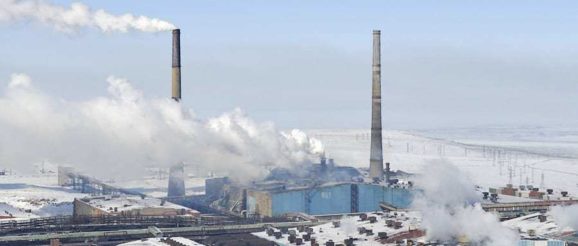Efficient extraction of methane from permafrost while burying CO2 – Innovation Toronto

Scientists from Skoltech and Heriot-Watt University proposed extracting methane by injecting flue gas into permafrost hydrate reservoirs. Since the flue gas contains carbon dioxide, the new technology will also contributes to reduction of this green house gas in the Arctic atmosphere. The results of their study were published in the journal Scientific reports.
The Russian Arctic is actively developing due to exploitation of recently discovered oil and gas fields. However, operations in the Arctic region face numerous geological challenges. One of the most serious of them is formation of gas hydrates in frozen rock mass. Gas hydrates are ice-like crystalline structures formed by water and gas molecules. Their accumulations strongly hinders oil and gas field development and triggers spontaneous methane emissions into the atmosphere on the Arctic coast and shelf.
The scientists from the Skoltech Center for Hydrocarbon Recovery (CHR) and from Heriot-Watt University (Edinburgh, Scotland) developed a unique method for extracting methane from permafrost gas-hydrates by injecting flue gases, generated by fuel combustion. The main sources of flue gas are waste gases from coal-burning power plants and metallurgical plants and other industrial facilities.
The research team has found optimal injection conditions and identified the effect of flue gases on the efficiency of methane recovery. It is important to emphasize that flue gas contains considerable amount of green-house carbon dioxide, that will also be buried subsurface. The carbon dioxide forms hydrate replacing the original methane hydrate. The new technology is essential for development of the hydrocarbon fields in the highly sensitive Arctic environment.
“Our approach not only helps extract methane and prevent its free release into the atmosphere but also reduce carbon dioxide emissions. I would say our method offers a double dividend in terms of environmental safety,” says Leading Research Scientist at CHR, Evgeny Chuvilin.
Learn more: Replacing one gas with another helps efficiently extract methane from permafrost
Go deeper with Bing News on:
Scientists have devised a new way of extracting methane gas from permafrost gas-hydrates. They say the discovery could increase the amount of methane recovered from these sites, while reducing the …
Scientists from Skoltech and Heriot-Watt University proposed extracting methane by injecting flue gas into permafrost hydrate reservoirs. Since the flue gas contains carbon dioxide, the new technology …
Scientists from Skoltech and Heriot-Watt University proposed extracting methane by injecting flue gas into permafrost hydrate reservoirs. Since the flue gas contains carbon dioxide, the new technology …
I’m sure that Mr. Stossel has encountered the evidence that further warming will enhance the release of methane from the permafrost of the arctic … have studied other aspects of science related to …
I’m sure that Mr. Stossel has encountered the evidence that further warming will enhance the release of methane from the permafrost of the arctic … have studied other aspects of science related to …
Methane hydrate grows at high pressure and lower temperature under seabed. Its inefficient extraction could release methane gas from permafrost, which can lead to the occurrence of tsunami. Such …
Methane hydrate grows at high pressure and lower temperature under seabed. Its inefficient extraction could release methane gas from permafrost, which can lead to the occurrence of tsunami. Such …
Furthermore, methane is released from swamp areas on land, melting permafrost in the Arctic tundra, and from areas with oxygen depletion in the oceans. We have a good understanding of the processes …
Furthermore, methane is released from swamp areas on land, melting permafrost in the Arctic tundra, and from areas with oxygen depletion in the oceans. We have a good understanding of the processes …
Go deeper with Google Headlines on:
Extraction of methane from permafrost
Go deeper with Bing News on:
Scientists have devised a new way of extracting methane gas from permafrost gas-hydrates. They say the discovery could increase the amount of methane recovered from these sites, while reducing the …
solid or gas. Amongst these, the transition between solid and liquid phases in advanced PCMs is considered to be the most viable commercially. At present, there are three main types of advanced PCMs …
solid or gas. Amongst these, the transition between solid and liquid phases in advanced PCMs is considered to be the most viable commercially. At present, there are three main types of advanced PCMs …
Scientists from Skoltech and Heriot-Watt University proposed extracting methane by injecting flue gas into permafrost hydrate reservoirs. Since the flue gas contains carbon dioxide, the new …
Scientists from Skoltech and Heriot-Watt University proposed extracting methane by injecting flue gas into permafrost hydrate reservoirs. Since the flue gas contains carbon dioxide, the new …
The gas hydrates prefer to cultivate themselves in between the interstitial pore spaces as well as in the internal nano spaces/pores of the porous materials. Naturally, the guest gas and water …
The gas hydrates prefer to cultivate themselves in between the interstitial pore spaces as well as in the internal nano spaces/pores of the porous materials. Naturally, the guest gas and water …
Dec 10, 2019 (Profound via COMTEX) — The report provides rational insights along with historical and forecast data to aid in better understanding of the Global Natural Gas Hydrates Market. The report …
Dec 10, 2019 (Profound via COMTEX) — The report provides rational insights along with historical and forecast data to aid in better understanding of the Global Natural Gas Hydrates Market. The report …
